Great Smoky Mountains National Park is full of waterfalls. You can drive right up to some, while others will take a bit of a hike to reach. And of course, some waterfalls are better than others. But, no matter which waterfalls you included on your itinerary to Great Smoky Mountains National Park, you’re sure to have a good view.
Best Waterfalls in Great Smoky Mountains National Park
This post does not contain an exhaustive list of every waterfall at Great Smoky Mountains National Park. That list would go on forever. Plus, despite visiting Great Smoky Mountains National Park across four separate days, I only scratched the surface of what is available to visitors. So, this list of waterfalls in Great Smoky Mountains National Park that I think you should check out. It’s based off my own experience, as well as based off the advice of rangers that I talked to while in the park.
As always, this list is in no particular order.
Abrams Falls
I know I said this list is in no particular order (although technically it’s in alphabetical order), Abrams Falls was my favorite of the four waterfall hikes I did at Great Smoky Mountains National Park. The waterfall was the most impressive and because my group got an early start, we had the trail (at least outgoing) and the waterfall all to ourselves.
Before we get into the details of this trail, I have to add a note about getting to the trailhead. The trailhead for Abrams Falls is off a spur of the extremely popular Cades Cove scenic loop. At the advice of a ranger, we arrived at the entrance to Cades Cove at sunrise (when the road first opened), and we crawled our way through the loop to our trailhead. Traffic was heavy and incredibly slow moving, even at sunrise. Make sure you are prepared for that before you venture out to this trail.
The Abrams Falls Trail is five miles long, but there’s an optional short, one mile add on to a historic cabin. We chose the extra mile add on to visit a historic cabin, but personally would have been ok if we had skipped it. I logged 6.4 miles and 750 feet of elevation on this hike, but it would have been only 5.2 miles had we not added on the cabin. The important thing to note is that this hike is mostly downhill to the falls, so you’ll find yourself climbing up at the end.
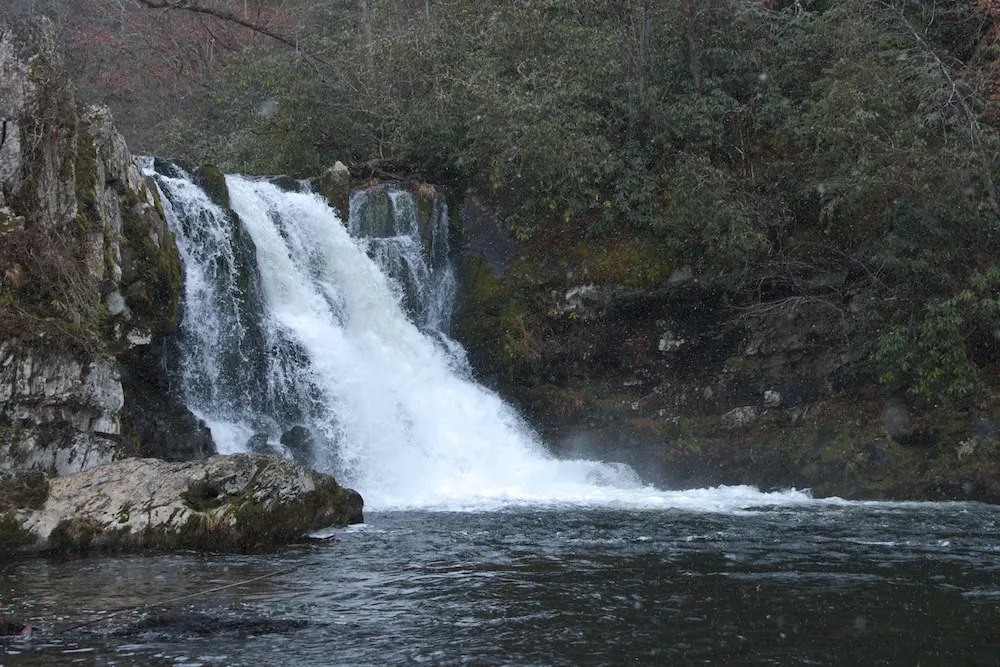
Cataract Falls
The short trail to Cataract Falls can be found right behind the Sugarland Falls Visitor Center. It’s a pretty flat trail and can be accomplished in about a mile. But because it’s such an easy trail, and right next to the Visitor Center, crowds on this trail can get heavy. While the trail was busy, I think my experience at Laurel Falls (mentioned later) was worse.
If you’re looking to get away from the crowds and get a little more exercise, you can hike the add on nature trail. When you cross the bridge, the main trail to the waterfall goes one way (to the right) while a nature trail goes the other (to the left). Nearly all visitors seem to go straight to the waterfall and ignore the nature trail. Admittedly the nature trail wasn’t the most spectacular scenery, but there was no one else on the trail, which was a huge bonus.
On the hike to Cataract Falls and the nature trail, I logged 2.1 miles and 141 feet of elevation gain. It look 50 minutes which included a substantial break at Cataract Falls.

Fern Branch Falls
Fern Branch Falls is located on the 8 mile Porters Creek Trail. While you can go all the way to the end of the trail, I think it’s totally reasonable to just stop once you hit Fern Branch Falls. That assumes that you don’t just hike right passed it like my group did. Yes, somehow we hiked right passed the waterfall we came to see (but it’s an out and back trail and we found it on the way back).
Fern Branch Falls is about two miles into the Porters Creek Trail, so the total hike to the falls (and back) is about 4 miles with about 700 feet of elevation. I think the elevation on the early part of the Porters Creek Trail is a lot more manageable than what comes on the second half of the trail. It felt pretty easy to me, but I’ll admit that 700 feet in two miles is a lot for some people.
My recommendation is that if you’re feeling worn out by Fern Branch Falls, just stop here. From Fern Branch Falls, you’ll climb up another 800+ feet that feels more steep than the first half of this trail. Doing the entire Porter Creek Trail is approximately 8 miles with 1500 feet of elevation change.
Compared to other trails on this list (Cataract Falls and Laurel Falls), traffic here wasn’t too bad. We passed a handful of people on the trail, but it felt like a totally reasonable number. And we passed more people on our way back (in early afternoon) than we did on our way out (a 10:30ish start time). So, if you want some peace on the trail, I recommend starting early.
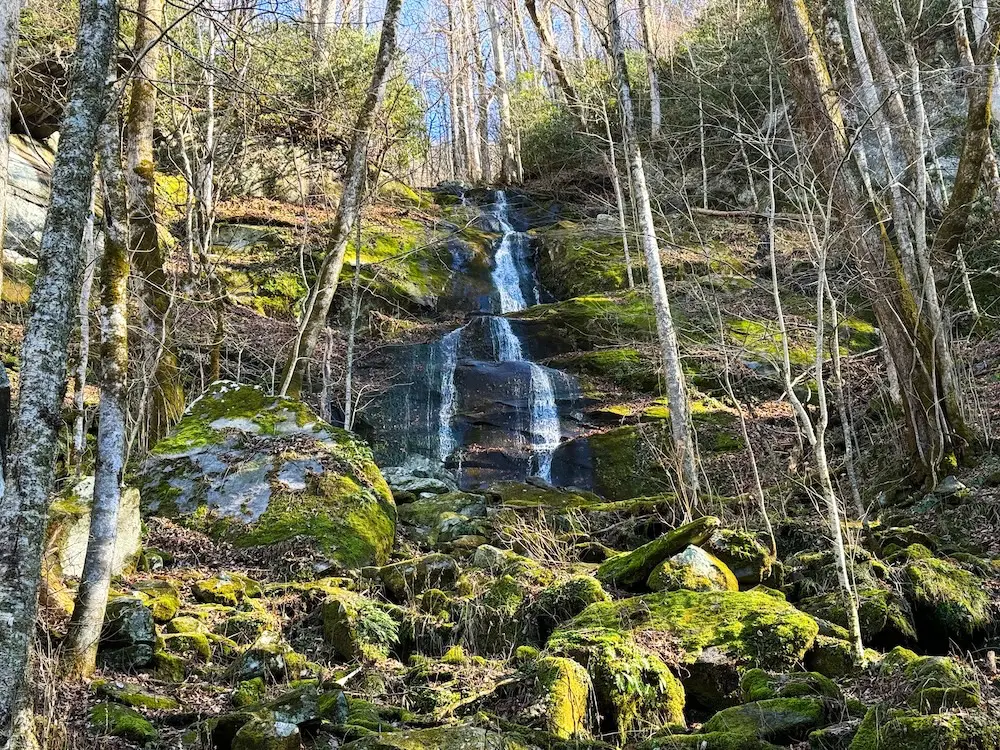
Laurel Falls
Of the four waterfalls I visited at Great Smoky Mountains National Park, this was by far the busiest. To an extent, it almost makes it unenjoyable because of the amount of people on the trail. But, it’s still one of the most popular hikes in Great Smoky Mountains National Park so I have to include it on this list.
Laurel Falls is a mostly paved trail. But don’t let that fool you. You’ll be climbing steadily uphill for most of the way, although I never found it particularly steep. Additionally, the pavement isn’t in super great shape. There’s cracks, uneven sections, and a few sections where the pavement is just missing from one side of the trail.
At one point, we passed a woman with a stroller who was just starting her hike. My entire group thought that didn’t seem like a great idea based simply on the condition of the pavement. It’s doable, but it’ll be more difficult than you may expect.
My tracker got a bit screwed up on this hike, so I don’t have good stats, but the trail is 2.4 miles with about 400 feet of elevation gain. That feels pretty accurate based off of what I was able to get from my tracker. It took my group about an hour to do this hike.
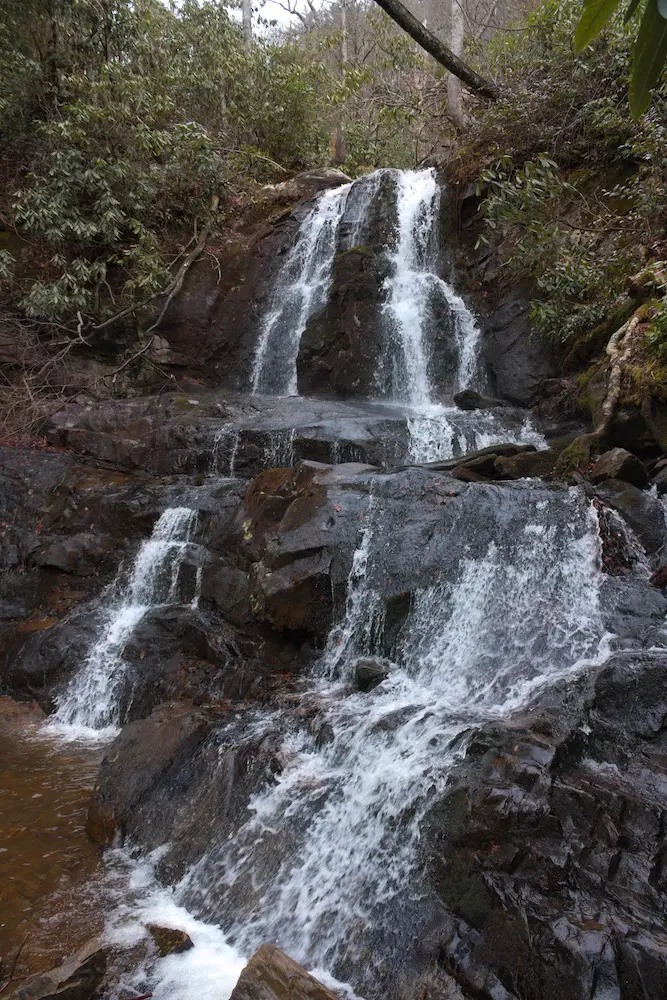
Bonus Waterfalls
I’ve already covered the four waterfalls that I hiked while visiting Great Smoky Mountains National Park, but here’s a few bonuses.
Grotto Falls
The trail to Grotto Falls was on our list, but a seasonal road closure prevented us from actually hiking it. That said, I was visiting with family who live in the area and several months later, they were actually able to get out to Grotto Falls and they enjoyed it.
Grotto Falls can be reached even in the off season, but you need to be prepared for a slightly longer hike. If you can reach the main parking lot, you’ll have about 2.6 miles with 550 feet of elevation. If you’re here in winter, prepare for nearly 7 miles and 1300 feet along the Trillium Gap Trail.
Ramsey Cascades
When we spoke to a ranger, she recommended either Fern Branch Falls or Ramsey Cascades for a good hike. We picked Fern Branch Falls, but because of the recommendation, I have to include Ramsey Cascades on this list.
This trail is 8 miles and has about 2200 feet of elevation change. It’s located in the Greenbrier area of Great Smoky Mountains National Park (near Fern Branch Falls and the Porter Creek Trail).
A Series of Three in North Carolina
This was not on my original list, because I didn’t plan to cross over into North Carolina. However, we talked to a ranger for advice about beating the crowds at Abrams Falls and Cades Cove. She also recommended a series of three waterfalls in North Carolina, so I’m passing that advice onto you. If you have the time, this may be a great option. And since it’s a further drive, you may be able to avoid some of the crowds you’ll find through the rest of the park.
In Deep Creek, you’ll find Juney Shank Falls, Indian Creek Falls, and Tom Brach Falls, all on the same convenient area. A loop of all three of these trails is about 2.5 miles with 450 feet of elevation change.
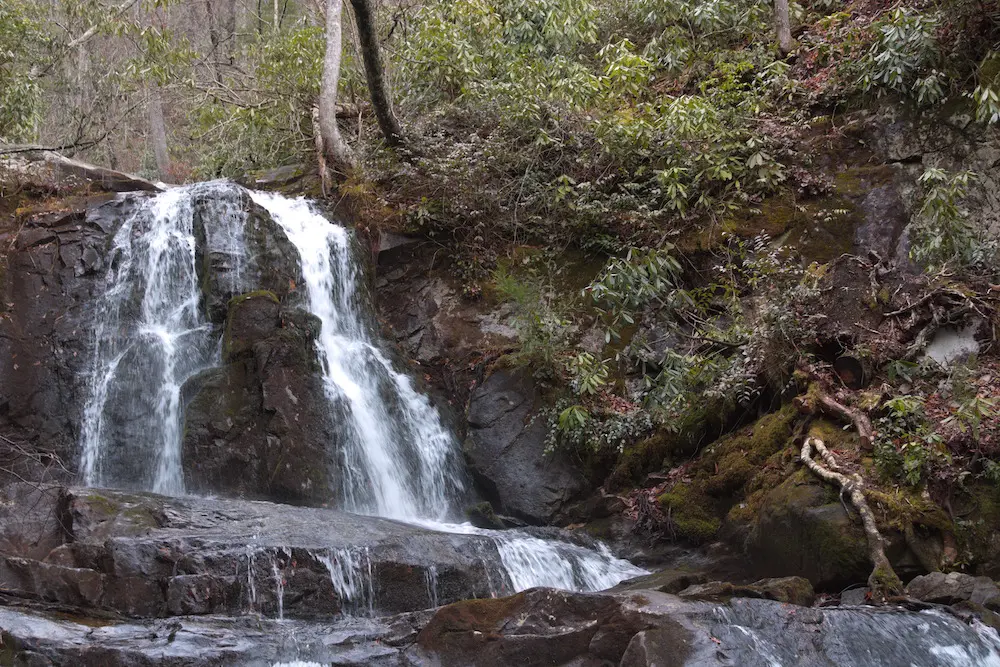
Which Waterfall Should You Visit
Obviously the choice is yours, but I recommend trying to find some lesser visited waterfalls. Sure, Laurel Falls and Cataract Falls were nice, but there were so many people on the trail that it took away from the experience. Both Fern Branch Falls and Abrams Falls were much more manageable and it felt like we had the trails to ourselves for long stretches.
If I had to pick, Abrams Falls was my favorite waterfall (and hike) of the trip.
Entry to Great Smoky Mountains National Park
There is no entry fee to visit Great Smoky Mountains National Park.
Parking at Great Smoky Mountains National Park
While the entry to Great Smoky Mountains is free, you do need to have a valid parking pass. Parking used to be free, but March 2023 saw the introduction of the “Park It Forward” program. Now, visitors must pay to park anywhere at Great Smoky Mountain National Park. Whether you are at a visitor center, an overlook, or a remote trailhead, you must have a valid parking permit.
Permits can be purchased from automated vending machines throughout the park. You’ll find them at visitor centers and other high trafficked areas.
The parking fee is $5 per vehicle per day, or $15 per vehicle per week. As a note, the pass is not transferrable and is tied the license plate of your vehicle. Before you go to one of the machines, make sure you know the license plate (especially if you’re driving a rental car!).
It is important to note that any inter-agency pass, such as the America the Beautiful pass, does NOT cover the parking fee. Even if you have an America the Beautiful (or similar pass), you will need to purchase a parking permit from one of the machines.
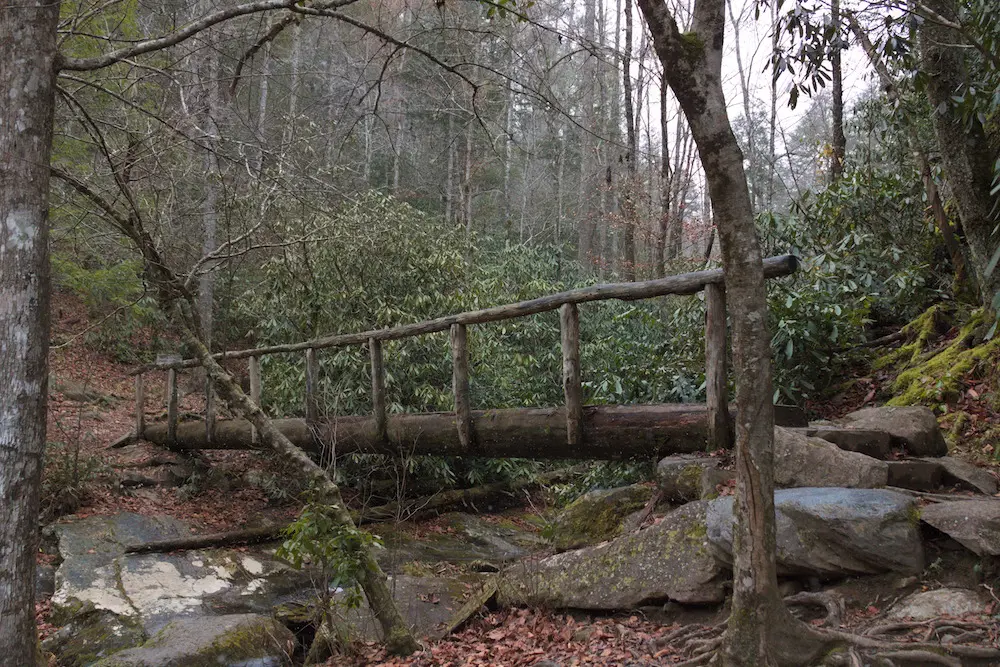
When to Visit Great Smoky Mountains National Park
Great Smoky Mountains National Park can be visited all year round. Summers can be down right hot. In addition, the summer months are the busiest. I visited in December (between Christmas and New Year’s). The weather varied dramatically, from snow flurries at Abrams Falls to beautiful sunshine at Fern Branch Falls.
However, just as important as the weather is crowd management. Great Smoky Mountains National Park is the most visited national park in the United States with nearly 13 million visitors per year. Some areas of the park feel downright overcrowded.
For those looking to avoid crowds, pick lesser traveled trails. My hikes at Abrams Falls and Fern Branch Falls felt much less traveled and it was easy to forget we were in the country’s most visited national park. We passed a handful of people, but it was completely manageable. Cataract Falls and Laurel Falls were outrageously busy.
For those looking for a balance between good weather and crowds, I’d look to late spring or in fall.
Where to Stay
Where to Stay at Great Smoky Mountains National Park
Great Smoky Mountains National Park straddles the Tennessee – North Carolina state line. Your exact location should be based on what specifically interests you, so you can cut down on your driving.
For many tourists though, the towns of Gatlinburg, Pigeon Forge, and Sevierville in Tennessee make great bases. Gatlinburg and Pigeon Forge specifically are massive tourist towns and traffic can be outrageous. My advice is to get an early start to try to beat the traffic. It’s no joke.
Final Thoughts
Great Smoky Mountains National Park has no shortage of waterfall hikes. I’ve said before that the hardest part will be choosing which waterfalls to hike and which to skip. But no matter which waterfalls you choose to visit, you’re sure to have a great visit to Great Smoky Mountains.
Continue Your Adventure
Great Smoky Mountains National Park: Learn about the best things to do at Great Smoky Mountains National Park, including the Cades Cove Scenic Drive. Take a longer hike with fewer people on the Porters Creek Trail. Get your trip started with a two day itinerary.
More in Appalachia: For more hiking in the Appalachia region of the United States, consider visiting Shenandoah National Park in Virginia or New River Gorge National Park in West Virginia. For a break from hiking, head to the Biltmore Estate in Asheville, North Carolina.
US National Parks: Start planning your national park vacation with my US National Park Travel Guide. You’ll find information about each park, photos, itineraries, budget tips, advice for non-hikers, the best scenic drives, and more. Plus, don’t forget to book your timed entry reservations in advance!
